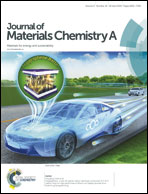Nanopore-confined g-C3N4 nanodots in N, S co-doped hollow porous carbon with boosted capacity for lithium–sulfur batteries†
Abstract
Benefiting from the high theoretical specific capacity and low cost consumption, lithium–sulfur batteries have been regarded as the promising next-generation energy storage technology. However, lithium–sulfur batteries still encounter a series of challenges such as low conductivity and serious volumetric expansion of sulfur during the discharge process as well as the stubborn “shuttle effect” of polysulfides. Such problems have greatly plagued the real applications of lithium–sulfur batteries. Herein, we have synthesized below-5-nm g-C3N4 nanodots based on a pore confinement effect, and they are embedded in a MOF-derived N, S co-doped hollow porous carbon shell (CN@NSHPC) via a unique double solvent-induced strategy. CN@NSHPC displays superior lithium polysulfide (LiPS) adsorptivity and a high sulfur loading of 73%. When applied as an electrode in lithium–sulfur batteries, the CN@NSHPC electrode delivers an excellent specific capacity of 1447 mA h g−1 at 0.2C, good rate capability of 387 mA h g−1 at 5C, and excellent cycling stability, specifically, only 0.048% decay per cycle at 1.0C over 500 cycles. This proposed strategy provides an insight into a new pathway to construct co-doped carbon hollow nanostructure and nanodot materials by the pore confinement effect.

- This article is part of the themed collection: International Year of the Periodic Table : Low Dimensional Carbon Systems


 Please wait while we load your content...
Please wait while we load your content...